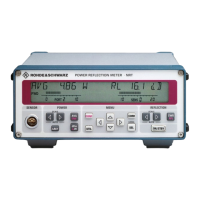Instrument Functions
NRP2
68User Manual 1173.9140.02 ─ 07
parameters "Excluded from Start" and "Excluded from End", the start and end of bursts
can be excluded from the measurement. This means that signal overshoots can be
omitted from measurements, for example.
Find some background information in sections "Dropout tolerance" on page 74 and
"Timing diagram of burst signals"
on page 74).
For the most common mobile radio standards, the required settings can directly be loa-
ded via the "Recall Standard" dialog box in the "File" menu see chapter 4.6.4, "Loading
settings for mobile radio standards", on page 142.
► Select "Burst Av" in the "Mode..." dialog box opened via the "Sensor" menu.
Fig. 4-6: Mode dialog box / Burst Av
Dropout
Defines the end of the burst. If power keeps low for at least this time, the end of the
burst is assumed. Modulation-specific power drops that are shorter than the set value
are ignored.
Note: The "Dropout" parameter must not be longer than the interval between the end
of the burst and the start of the next burst.
Remote command:
[SENSe<[1]..4>][:
POWer]:
BURSt:DTOLerance on page 274
Excluded from Start/End
Set the time interval at the beginning or end of the burst that is excluded from the mea-
surement.
Remote command:
[SENSe<[1]..4>]:TIMing:
EXCLude:STOP on page 283
[SENSe<[1]..4>]:TIMing:EXCLude:STARt on page 283
4.2.1.4 Measuring the average power of TDMA signals
The average power values of timeslots can be measured in the timeslot mode. The
time resolution is determined by the sampling rate of the sensor. This mode is availa-
ble in the multipath power sensors (R&S NRP-Z11/21/22/23/24/28/31/32) and in the
R&S NRP-Z8x wideband power sensors.
Data acquisition and parameters
北京海洋兴业科技股份有限公司(证券代码:839145)

